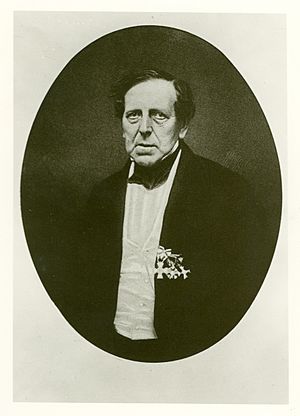Martin Rathke facts for kids
Martin Heinrich Rathke (born August 25, 1793, died September 3, 1860) was a German scientist. He was an expert in embryology and anatomy. Embryology is the study of how living things develop before they are born or hatched. Anatomy is the study of the body's structure. Martin Rathke is known as one of the people who helped start modern embryology.
Contents
Martin Rathke: Early Life and Studies
Martin Rathke was born in Danzig, which is now Gdańsk, Poland. He studied medicine and natural history at the University of Göttingen. Natural history is the study of nature, including animals and plants.
After Göttingen, he moved to Berlin. There, he earned his doctorate degree in medicine in 1818. This means he completed his advanced studies to become a doctor.
A Professor's Journey
In 1828, Rathke became a professor at the University of Dorpat. He taught about how bodies work (physiology) and how diseases affect them (pathology). He also taught semiotics, which is the study of signs and symbols.
He loved to explore! In 1832 and 1833, he went on research trips. He traveled to Finland and also to the Crimea, a peninsula in Eastern Europe.
From 1835 until he died in 1860, Rathke was a professor in Königsberg. He taught zoology, the study of animals, and anatomy. In 1839, he traveled to Scandinavia. There, he studied many different creatures living in the sea.
Amazing Discoveries in Development
Martin Rathke spent a lot of time studying sea creatures. He also focused on how living things develop from an embryo. An embryo is an early stage of development for an animal or human.
How Bodies Develop
He was the first to describe certain parts in the embryos of mammals and birds. These parts are called brachial clefts and gill arches. They are important structures that help form parts of the head and neck.
In 1839, he also described an important embryonic structure. It is now known as Rathke's pouch. This small pouch later develops into a key part of the brain called the pituitary gland. The pituitary gland controls many body functions.
The Mystery of the Amphioxus
Rathke made another big discovery about a small sea creature. This creature is called the amphioxus. Before Rathke, scientists thought the amphioxus was just the larva (young form) of a mollusk. Mollusks are soft-bodied animals like snails or clams.
But Rathke was the first to figure out that the amphioxus was not a larva. It was actually a completely separate type of animal! This was a very important discovery for understanding animal groups.
He wrote many books and papers about his studies. He wrote about crustaceans (like crabs), mollusks, and worms. He also wrote about vertebrates, which are animals with backbones. These included animals like the lemming and different types of reptiles.


